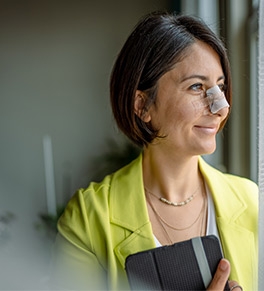
Rhinoplasty is cosmetic surgery involving the structure of the nose. While many people associate nose jobs with aesthetic surgery to improve appearance, rhinoplasty procedures are often done for functional reasons.
Functional issues affecting your ability to breathe are more than just cosmetic. Because of their negative impact on health and overall quality of life, functional problems of the nasal passages are medical conditions that often necessitate corrective measures.
At The Yeung Institute, Cecil S. Yeung, MD, FACS, and Daniela Burchhardt, MD, perform functional rhinoplasty to help patients breathe better and dramatically improve their quality of life. We often recommend functional rhinoplasty when breathing through your nose is labored or impossible due to the structure of your nasal valves.
Reasons to consider a functional rhinoplasty
Your nose is a complex structure of bone and cartilage. If your nasal valves are narrow, deformed, or collapsed, breathing through your nose is difficult. Everyone is unique, and no anatomical diagnosis is exactly the same. When you come to The Yeung Institute for your functional rhinoplasty, we conduct a complete evaluation of your condition and symptoms, including X-rays.
The structure inside your nose can be irregular — making nasal breathing difficult — for many reasons. From congenital defects present at birth to the result of surgery or an injury, irregularities in the nasal passages can affect normal nasal function.
There are many conditions that can be improved with functional rhinoplasty, including:
- Deviated nasal septum
- Nasal birth defect
- Nasal injury or trauma, such as broken nose
- Obstructed nasal breathing
- Narrow nasal valves
- Collapsed nasal valves, sometimes occurring with age
Functional rhinoplasty can dramatically improve or restore your ability to breathe through your nose. Rhinoplasty can improve facial symmetry, treat sleep apnea, reduce snoring, and more. You don’t have to live with nasal breathing issues — functional rhinoplasty is a proven procedure to significantly improve your health.
What to expect during your functional rhinoplasty
Prior to your functional rhinoplasty procedure, we develop a custom treatment plan for you and discuss your goals. Depending on your situation, we may use local anesthesia or general anesthesia during surgery.
We begin by making incisions inside your nostrils or at the base of your nose to access the bone and cartilage inside your nose. We use cartilage grafting — cartilage from another area — to build up the nasal passageways and support wider valves. In some cases, we may purposefully fracture nasal bones to straighten them if they are crooked or deformed, impacting your ability to breathe.
After your functional rhinoplasty procedure, we tape your nose and may place packing inside your nose temporarily. You can expect to wear protective bandaging for about a week while your nose heals. During this time, you should follow recovery instructions and avoid strenuous activity.
As with all surgical procedures, functional rhinoplasty has some risks. Complications aren’t common, but can include infection, nosebleed, septal perforation, or unsatisfactory appearance. It’s important to understand the risks and benefits of functional rhinoplasty before proceeding with surgery.
Functional rhinoplasty’s primary benefit is a significant improvement in your nasal airflow, making breathing easier. Rhinoplasty can also straighten your nose and repair deformity due to trauma or congenital conditions. Many patients who undergo functional rhinoplasty report significantly improved quality of life post-surgery.
Are you ready to learn if functional rhinoplasty is the answer to your breathing problems? Let our team help you find the right solution. Call our office or schedule your initial consultation online with our convenient booking tool to learn more about functional rhinoplasty.









